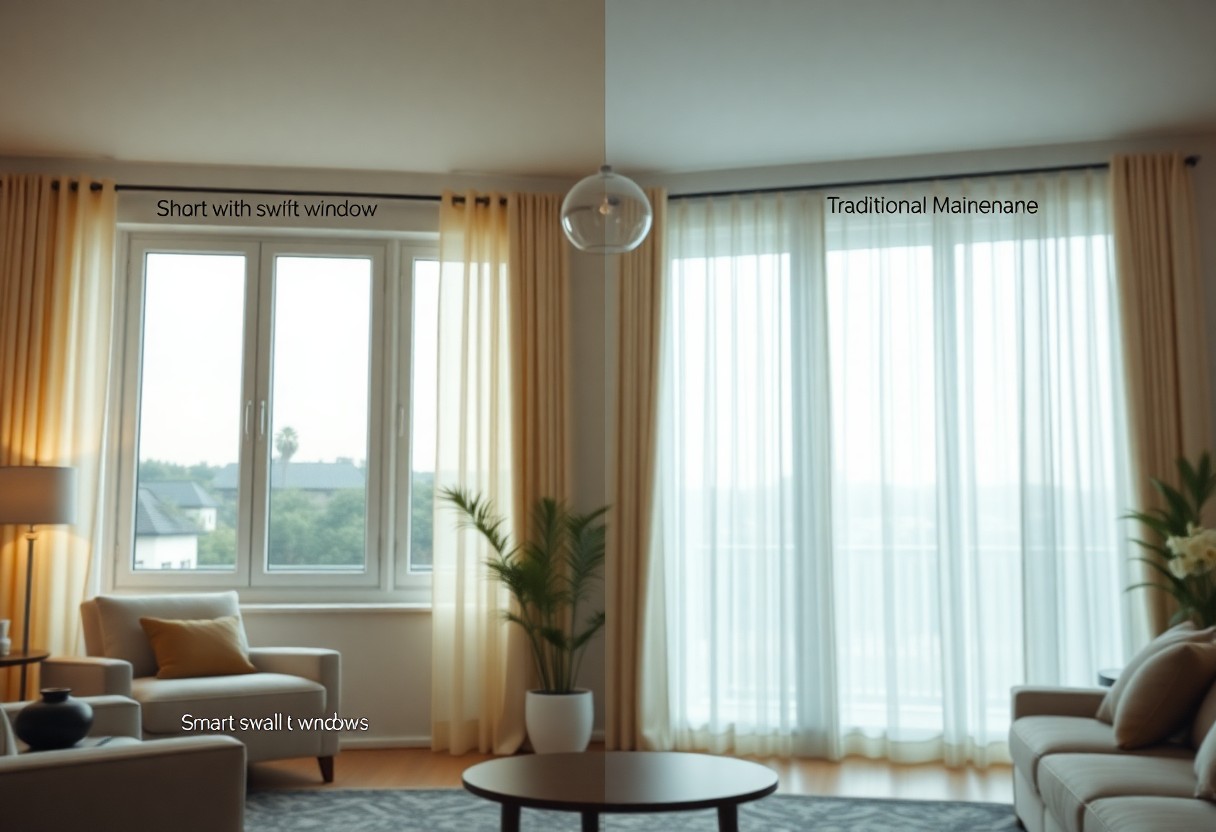SmartFilm technology is revolutionizing how you view and manage light in your home, offering a sleek alternative to traditional window treatments. As you weigh the benefits of smart film against conventional curtains or blinds, it’s crucial to consider factors like energy efficiency, privacy, and aesthetics. In this post, we’ll explore the key differences between these options, helping you decide which solution best fits your lifestyle and design preferences. Whether you seek modern convenience or timeless style, understanding your choices will empower you to create the perfect ambiance in your space.
The Technology Behind Smart Film
Smart film technology has revolutionized traditional window treatments by providing solutions that adjust light, enhance privacy, and boost energy efficiency with just the flip of a switch. This innovative film is typically composed of a polymer layer that can switch between transparent and opaque states when electric current is applied, allowing you to control your environment seamlessly. With options for integration into existing windows and easy installation, smart film offers a modern approach to managing light and privacy in your home.
How Smart Film Functions
The function of smart film hinges on its electrochromic properties, where applying voltage changes its opacity from clear to frosted. This change occurs in seconds, allowing you to easily switch between privacy and visibility as desired. When the power is off, the film remains transparent, providing an unobstructed view, while turning on the power transforms it into an opaque barrier, perfect for moments when you need seclusion.
Key Innovations and Advancements
Recent advancements in smart film technology include increased energy efficiency and enhanced durability, with films designed to withstand temperature fluctuations and UV exposure. Developers have also been focusing on reducing energy consumption, leading to films that require less power for operation. Some smart films are now integrated with smart home systems, allowing you to control them via mobile apps or voice commands for a truly seamless experience.
These innovations have pushed the boundaries of what smart film can achieve, presenting exciting possibilities for customization and integration. For instance, some smart films now offer multi-zone functionalities, enabling you to create different settings in various parts of a single room. Furthermore, advancements in materials have resulted in thinner, lighter films that maintain excellent clarity while contributing to overall energy savings. With clear benefits in sustainability and convenience, the evolution of smart film continues to cater to modern homeowners seeking style and functionality. As technology progresses, you can expect even more smart features, making these films an increasingly smarter investment for your home.
The Aesthetic Appeal of Traditional Window Treatments
Traditional window treatments such as drapes, curtains, and blinds not only serve functional purposes, but they also enhance the overall aesthetic of your space. With a wide range of materials, patterns, and colors, they can complement any interior design theme, from classic to contemporary. Choosing the right window treatment can tie your room together, creating a cohesive look that reflects your personal style while adding warmth and charm.
Design Versatility and Customization Options
One of the standout features of traditional window treatments is their design versatility. You can easily customize them to fit your specific needs and taste. Whether you choose to layer sheer curtains over heavier drapes for a luxurious look, or opt for intricate valances, the possibilities for customization are endless. This flexibility allows you to align your window treatments with your home’s décor, making it a seamless part of your design scheme.
Timeless Styles and Textures
Classic window treatments are associated with timeless designs that transcend passing trends, making them a go-to choice for many homeowners. Materials like silk, cotton, and linen not only provide a tactile richness but also transform light in unique ways, creating shadows and highlights that enhance your space. Patterns such as florals, stripes, and plaids have been beloved for generations, adding character and texture while maintaining an elegant look.
Timeless styles and textures in window treatments hold a special place in home design. For instance, elegant silk or velvet drapes can evoke a sense of sophistication, while soft cotton blends offer a more relaxed vibe. Layering different fabrics can add depth and interest, allowing you to play with light and privacy. Choosing patterns and colors that have endured through the years means you’re likely to maintain a classic look that will remain visually appealing long after passing trends fade away. Opting for these timeless options ensures your space feels inviting and stylish, regardless of changing aesthetics.
The Cost Considerations: Smart Film vs. Traditional Treatments
Initial Investment and Installation Costs
Smart film generally carries a higher upfront cost compared to traditional window treatments. The price for smart film can range from $8 to $15 per square foot, depending on the manufacturer and specific features. Installation costs also vary; while traditional treatments like curtains or blinds might only require basic mounting, smart film installation can demand professional expertise, potentially adding hundreds of dollars to your total initial investment.
Long-Term Savings and Value Assessments
The benefits of smart film often extend far beyond the initial costs, leading to substantial long-term savings. Energy-efficient smart film helps regulate indoor temperatures, which can translate into lower utility bills. Over time, this technology typically pays for itself, especially in climates with extreme temperatures. Furthermore, smart film can enhance your property’s market value, attracting potential buyers looking for modern amenities.
Evaluating long-term savings requires careful calculation of energy savings, as smart film can reduce cooling costs by up to 30% by blocking excessive heat while allowing natural light. If you’re considering how this impacts your home’s value, keep in mind that energy-efficient upgrades are highly sought after in real estate markets. Research shows that homes equipped with advanced technology, including smart window treatments, can command higher selling prices, often recovering the cost of installation and providing additional equity for your property. By opting for smart film, you invest not just in a contemporary look, but in a smarter, more economical future for your home.
Energy Efficiency and Environmental Impact
Evaluating energy efficiency is crucial when comparing smart film and traditional window treatments. Both options contribute to reducing energy consumption and enhancing your home’s sustainability, but they do so in different ways. Understanding their impacts can help you choose the option that best aligns with your environmental goals and energy savings objectives.
Smart Film’s Contribution to Energy Conservation
Smart film helps to minimize energy use by controlling heat gain and loss through your windows. It functions by adjusting its tint based on sunlight exposure, reflecting and absorbing heat as needed. This technology can lower air conditioning demands during hot months, achieving energy savings of up to 30% in some cases, ultimately reducing your carbon footprint and energy bills.
Traditional Treatments’ Role in Insulation and Energy Savings
Traditional window treatments, such as heavy drapes and insulating shades, offer significant insulation benefits. They can effectively block drafts and minimize heat transfer, which helps to keep your indoor temperatures stable. Using layered treatments can enhance energy savings; for example, a pair of blackout curtains combined with cellular shades can improve a home’s energy efficiency by up to 25% in colder seasons.
By strategically utilizing traditional treatments, you create an additional barrier against outside temperatures. The thick fabric of drapes or the cellular structure of shades traps air, reducing the exchange of heat with the outdoors. This not only contributes to your comfort but also aids in reducing reliance on heating and cooling systems, enhancing overall energy efficiency in your home. Plus, these treatments often come in an array of styles and colors, allowing you to marry form with function seamlessly.

Maintenance and Longevity: A Comparative Analysis
| Smart Film | Traditional Window Treatments |
|---|---|
| Low-maintenance; requires simple cleaning with a soft cloth | Often requires regular dusting, vacuuming, or washing |
| Less prone to damage; typically lasts over 10 years | Varied lifespan; some fabrics may fade or degrade within 5 years |
| No mechanical parts, minimizing wear and tear | Potential for wear on cords and fixtures, requiring replacement |
Care Requirements for Smart Film
Smart film’s maintenance is straightforward; all you need is a soft cloth for cleaning, avoiding harsh chemicals that may damage the film. Regular dusting is usually sufficient to keep it looking pristine, and as it does not have any mechanical components, there’s minimal wear over time. With proper care, smart film can easily last a decade or more, making it a practical choice for your home.
Durability and Lifespan of Window Treatments
Window treatments vary widely in durability and lifespan depending on material and design. For instance, wood blinds can last around 10-15 years, but they are prone to warping and fading. Fabrics may last around 5 years before showing signs of wear, especially in sunny areas. Regular maintenance, such as cleaning and addressing wear and tear, can extend their life but may still require eventual replacement.
Choosing window treatments means weighing potential durability against aesthetic goals. Treatments like wooden shades, while elegant, may suffer from environmental damage or color fading, significantly affecting their longevity. In contrast, metallic or synthetic alternatives may offer better resistance to the elements but could lack the warmth of natural materials. Smart film stands out for durability, providing a modern solution to avoid the frequent turnover that many traditional materials require.
Conclusion
To wrap up, choosing between smart film and traditional window treatments depends on your specific needs and lifestyle. If you value cutting-edge technology, energy efficiency, and the ability to control privacy and light at a touch, smart film may be the perfect fit for your home. Alternatively, if you prefer a classic aesthetic with a range of design options, traditional window treatments could be the way to go. Ultimately, weigh the benefits of each solution against your personal preferences and budget to make the best choice for your space.





